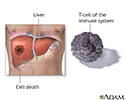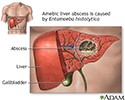Amebic liver abscess
Hepatic amebiasis; Extraintestinal amebiasis; Abscess - amebic liverAmebic liver abscess is a collection of pus in the liver in response to an intestinal parasite called Entamoeba histolytica.
Causes
Amebic liver abscess is caused by a parasite called Entamoeba histolytica. This parasite causes amebiasis, an intestinal infection that is also called amebic dysentery. After an infection has occurred, the parasite may be carried by the bloodstream from the intestines to the liver.
Amebiasis
Amebiasis is an infection of the intestines. It is caused by the microscopic parasite Entamoeba histolytica.

Amebiasis spreads from eating food or water that has been contaminated with feces. This is sometimes due to the use of human waste as fertilizer. Amebiasis is also spread through person-to-person contact.
The infection occurs worldwide. It is most common in tropical areas where crowded living conditions and poor sanitation exist. Africa, Latin America, Southeast Asia, and India have significant health problems from this disease.
Risk factors for amebic liver abscess include:
- Recent travel to a tropical region
- Alcoholism
- Cancer
-
Immunosuppression, including HIV/AIDS infection
Immunosuppression
Immunodeficiency disorders occur when the body's immune response is reduced or absent.
 ImageRead Article Now Book Mark Article
ImageRead Article Now Book Mark Article - Malnutrition
- Old age
- Pregnancy
- Steroid use
Symptoms
There are usually no symptoms of intestinal infection. But people with amebic liver abscess do have symptoms, including:
- Abdominal pain, more so in the right, upper part of the abdomen; pain is intense, continuous or stabbing
-
Cough
Cough
Coughing is an important way to keep your throat and airways clear. But too much coughing may mean you have a disease or disorder. Some coughs are d...
 ImageRead Article Now Book Mark Article
ImageRead Article Now Book Mark Article -
Fever and chills
Fever
Fever is the temporary increase in the body's temperature in response to a disease or illness. A child has a fever when the temperature is at or abov...
 ImageRead Article Now Book Mark Article
ImageRead Article Now Book Mark ArticleChills
Chills refers to feeling cold after being in a cold environment. The word can also refer to an episode of shivering along with paleness and feeling ...
 ImageRead Article Now Book Mark Article
ImageRead Article Now Book Mark Article -
Diarrhea, non-bloody (in only one-third of people with amebic liver abscess)
Diarrhea, non-bloody
Diarrhea is when you pass loose or watery stool.
 ImageRead Article Now Book Mark Article
ImageRead Article Now Book Mark Article - General discomfort, uneasiness, or ill feeling (malaise)
Malaise
Malaise is a general feeling of discomfort, illness, or lack of well-being.
Read Article Now Book Mark Article -
Hiccups that do not stop (rare)
Hiccups
A hiccup is an unintentional movement (spasm) of the diaphragm, the muscle at the base of the lungs. The spasm is followed by quick closing of the v...
Read Article Now Book Mark Article -
Jaundice
(yellowing of the skin, mucous membranes, or eyes)
Jaundice
Jaundice is a yellow color of the skin, mucus membranes, or eyes. The yellow coloring comes from bilirubin, a byproduct of old red blood cells. Jau...
 ImageRead Article Now Book Mark Article
ImageRead Article Now Book Mark Article -
Loss of appetite
Loss of appetite
A decreased appetite is when your desire to eat is reduced. The medical term for a loss of appetite is anorexia.
Read Article Now Book Mark Article -
Sweating
Sweating
Sweating is the release of liquid from the body's sweat glands. This liquid contains salt. This process is also called perspiration. Sweating helps...
 ImageRead Article Now Book Mark Article
ImageRead Article Now Book Mark Article - Weight loss
Exams and Tests
Your health care provider will perform a physical examination. You'll be asked about your symptoms and recent travel. Tests that may be done include:
-
Abdominal ultrasound
Abdominal ultrasound
Abdominal ultrasound is a type of imaging test. It is used to look at organs in the abdomen, including the liver, gallbladder, spleen, pancreas, and...
 ImageRead Article Now Book Mark Article
ImageRead Article Now Book Mark Article -
Abdominal CT scan or MRI
Abdominal CT scan
An abdominal CT scan is an imaging method. This test uses x-rays to create cross-sectional pictures of the belly area. CT stands for computed tomog...
 ImageRead Article Now Book Mark Article
ImageRead Article Now Book Mark ArticleMRI
An abdominal magnetic resonance imaging scan is an imaging test that uses powerful magnets and radio waves. The waves create pictures of the inside ...
 ImageRead Article Now Book Mark Article
ImageRead Article Now Book Mark Article -
Complete blood count
Complete blood count
A complete blood count (CBC) test measures the following:The number of white blood cells (WBC count)The number of red blood cells (RBC count)The numb...
 ImageRead Article Now Book Mark Article
ImageRead Article Now Book Mark Article - Liver abscess aspiration to check for bacterial infection in the liver abscess
-
Liver scan
Liver scan
A liver scan uses a radioactive material to check how well the liver or spleen is working and to assess masses in the liver.
 ImageRead Article Now Book Mark Article
ImageRead Article Now Book Mark Article -
Liver function tests
Liver function tests
Liver function tests are common tests that are used to see how well the liver is working. Tests include:AlbuminAlpha-1 antitrypsinAlkaline phosphata...
 ImageRead Article Now Book Mark Article
ImageRead Article Now Book Mark Article - Blood test for amebiasis
-
Stool testing for amebiasis
Stool testing
Stool ova and parasites exam is a lab test to look for parasites or eggs (ova) in a stool sample. The parasites are associated with intestinal infec...
 ImageRead Article Now Book Mark Article
ImageRead Article Now Book Mark Article
Treatment
Antibiotics such as metronidazole (Flagyl) or tinidazole (Tindamax) are the usual treatment for liver abscess. A medicine such as paromomycin or diloxanide must also be taken to get rid of all the ameba in the intestine and to prevent the disease from coming back. This treatment can usually wait until after the abscess has been treated.
In rare cases, the abscess may need to be drained using a catheter or surgery to relieve some of the abdominal pain and to increase chances of treatment success.
Outlook (Prognosis)
Without treatment, the abscess may break open (rupture) and spread into other organs, leading to death. People who are treated have a very high chance of a complete cure or only minor complications.
Possible Complications
The abscess may rupture into the abdominal cavity, the lining of the lungs, the lungs, or the sac around the heart. The infection can also spread to the brain.
When to Contact a Medical Professional
Contact your provider if you develop symptoms of this disease, especially if you have recently traveled to an area where the disease is known to occur.
Prevention
When traveling in tropical countries with poor sanitation, drink purified water and do not eat uncooked vegetables or unpeeled fruit.
References
Huston CD. Intestinal protozoa. In: Feldman M, Friedman LS, Brandt LJ, eds. Sleisenger and Fordtran's Gastrointestinal and Liver Disease. 11th ed. Philadelphia, PA: Elsevier; 2021:chap 113.
Petri WA, Haque R, Moonah SN. Entamoeba species, including amebic colitis and liver abscess. In: Bennett JE, Dolin R, Blaser MJ, eds. Mandell, Douglas, and Bennett's Principles and Practice of Infectious Diseases. 9th ed. Philadelphia, PA: Elsevier; 2020:chap 272.
-
Liver cell death - illustration
Organisms that carry disease can travel through the blood stream into the liver and form an abscess, a collection of infected tissue and pus.
Liver cell death
illustration
-
Amebic liver abscess - illustration
Amebic liver abscess is a collection of pus in the liver in response to an intestinal parasite called Entamoeba histolytica. This parasite causes amebiasis, an intestinal infection that is also called amebic dysentery. After an infection has occurred, the parasite may be carried by the bloodstream from the intestines to the liver.
Amebic liver abscess
illustration
-
Liver cell death - illustration
Organisms that carry disease can travel through the blood stream into the liver and form an abscess, a collection of infected tissue and pus.
Liver cell death
illustration
-
Amebic liver abscess - illustration
Amebic liver abscess is a collection of pus in the liver in response to an intestinal parasite called Entamoeba histolytica. This parasite causes amebiasis, an intestinal infection that is also called amebic dysentery. After an infection has occurred, the parasite may be carried by the bloodstream from the intestines to the liver.
Amebic liver abscess
illustration
Review Date: 5/19/2023
Reviewed By: Jatin M. Vyas, MD, PhD, Associate Professor in Medicine, Harvard Medical School; Associate in Medicine, Division of Infectious Disease, Department of Medicine, Massachusetts General Hospital, Boston, MA. Also reviewed by David C. Dugdale, MD, Medical Director, Brenda Conaway, Editorial Director, and the A.D.A.M. Editorial team.




